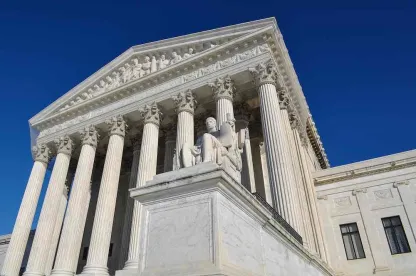After going several weeks without adding cases to its docket, on Nov. 4 the U.S. Supreme Court set more cases for argument this term, including a case on whether the Lanham Act’s trademark-infringement provisions apply extraterritorially involving the extent of the federal government’s obligations to ensure the Navajo Nation’s access to water in the southwestern United States.
Both of these cases could have significant consequences, and will be closely followed by intellectual property litigators and Indian-law practitioners, respectively.
Trademark-Infringement Suit Raises Question on Lanham Act Applicability to Foreign Sales
In Abitron Austria v. Hetronic International, the Court will consider the extraterritorial reach of the Lanham Act. The case is a suit brought by Hetronic International, a U.S. manufacturer of radio remote controls for heavy-duty construction equipment, against its foreign distributors (several related German and Austrian companies) for making and selling Hetronic-branded products in Europe without Hetronic’s permission. Hetronic claims the defendants’ foreign sales infringed its U.S.-registered trademarks, and for these sales a jury sitting in the Western District of Oklahoma ultimately awarded Hetronic approximately $90 million in damages.
The defendants appealed, arguing that the Lanham Act does not apply to sales made by foreign defendants to foreign consumers in foreign countries: They contend that 1) the Lanham Act does not expressly authorize extraterritorial application and thus the presumption against extraterritoriality applies, 2) under international law a trademark protects the markholder’s reputation only in the domestic market where the trademark is registered, and 3) applying the Lanham Act to sales between foreign nationals would raise serious constitutional concerns.
The U.S. Court of Appeals for the Tenth Circuit, however, affirmed the jury verdict and held that the Lanham Act can apply extraterritorially. The Tenth Circuit began by noting that the Lanham Act prohibits trademark-infringing branding from being “use[d] in commerce,” which it defines broadly as “all commerce which may lawfully be regulated by Congress.” It further observed that 50 years ago in Steele v. Bulova Watch Co., the Supreme Court read this language to authorize a Lanham Act suit brought by a U.S. plaintiff against a U.S. defendant for trademark infringement “consummated in a foreign country.” Because Steele involved a U.S. defendant, however, the Tenth Circuit acknowledged that it “leaves much unanswered about the extent of the Lanham Act's extraterritorial reach—particularly, as in our case, as it relates to foreign defendants.”
The Tenth Circuit then concluded that the Lanham Act can apply extraterritorially to foreign defendants where 1) the defendant's conduct had a substantial effect on U.S. commerce and 2) extraterritorial application would not create a conflict with trademark rights established under foreign law. And it held that Hetronic satisfied this test because “millions of euros worth of infringing products found their way into the United States and … caused confusion among U.S. consumers,” and because the defendants’ infringement “diverted tens of millions of dollars of foreign sales from Hetronic that otherwise would have ultimately flowed into the United States.”
Citing the variety of lower-court answers to this extraterritoriality question, the defendants filed a cert. petition asking the Supreme Court to decide when, if ever, the Lanham Act applies to foreign sales. The Court then called for the views of the U.S. Solicitor General, who recommended granting the petition – and, notably, argued that the Lanham Act applies to a foreign defendant’s use of a U.S. trademark abroad only if that particular use is likely to cause confusion in the United States.
The Supreme Court has now agreed to settle this question. And as this case illustrates, whichever rule the Court chooses, its answer will have considerable economic consequences.
Court Set to Decide Whether Navajo Nation Can Sue Federal Government for Failing to Provide for Necessary Water
Department of Interior v. Navajo Nation confronts the Court with a complicated case involving the extent of the federal government’s obligations to assess and meet the Navajo Nation’s need for water, including water from the Colorado River (which forms the Nation’s western boundary). Because much of the land in the Colorado River basin is arid, access to its water has long been a matter of dispute. For example, in the long-running Arizona v. California case (initially filed in 1952) the Supreme Court has exercised its original jurisdiction to quantify the water rights of several states and Indian tribes to the Colorado River.
Notably, in Arizona the federal government – which represented the Navajo Nation as tribal trustee – refused to press a Colorado River claim for the Navajo Nation and successfully opposed the Nation’s attempt to intervene. Arizona, to which the Court has returned several times in the last half-century, thus did not quantify any Colorado River rights the Navajo Nation may have, and the Court’s decree specifically provides that it does not affect “[t]he rights or priorities, except as specific provision is made herein, of any Indian Reservation.”
In this case, meanwhile, the Navajo Nation has brought a breach-of-trust claim against the federal government, seeking an injunction requiring the government to evaluate the Nation’s water needs and to develop a plan to secure the necessary water. The Nation contends that treaties the federal government signed in 1849 and 1868, which promised the Nation a permanent homeland and the seeds and tools needed to farm, implicitly conferred on the Nation concomitant rights to sufficient water – and, the Nation argues, imposed a duty on the government to assess, preserve, and protect those water rights. The Nation invokes the doctrine of Winters v. United States, a 1908 decision that, the Supreme Court has later explained, holds that the establishment of an Indian reservation “by implication, reserves appurtenant water then unappropriated to the extent needed to accomplish the purpose of the reservation.”
The U.S. Court of Appeals for the Ninth Circuit agreed with the Navajo Nation and held that the Nation could proceed with its breach-of-trust claim. The federal government, along with several states and local water districts, then sought Supreme Court review. Quoting the Court’s 2011 decision in United States v. Jicarilla Apache Nation, their cert. petitions argue that to bring a breach-of-trust claim against the federal government an Indian tribe must “identify a specific, applicable, trust-creating statute or regulation that the Government violated.” And, the cert. petitions contend, water rights implied under the Winters doctrine do not impose the specific, explicit duties required by Jicarilla. The states and local water districts also add the argument that the Nation’s suit impermissibly intrudes on the exclusive jurisdiction the Supreme Court retained in Arizona (to this contention the Navajo Nation responds that its suit does not seek a quantification of its rights in the Colorado River and thus does not implicate Arizona).
The Supreme Court is now set to resolve both of these arguments – whether water rights implied under Winter can give rise to breach-of-trust claims, and whether this suit intrudes on the jurisdiction the Court retained in Arizona. The Court’s decision will have significant practical effects on the Navajo Nation and other communities in the Colorado River basin. And more broadly, it could have significant legal repercussions for breach-of-trust claims and unquantified reserved water rights involving Tribes across the country.




 />i
/>i

